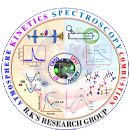Temperature-dependent rate coefficients for the photo oxidation reaction of ethyl propionate with Cl atom were investigated experimentally using the relative rate technique. Gas chromatography with flame ionization detector (GC-FID), gas chromatography–mass spectrometry (GC–MS), and GC-infrared spectroscopy (GC-IR) were used to follow the concentrations and identification of reactants and products. The kinetics of ethyl propionate with Cl atoms was investigated over the temperature range of 263–363 K at atmospheric pressure, relative to C2H6 and C2H4. Theoretical calculations were also performed at CCSD(T)/6-311++G(d,p)//BHandHLYP/6-311G(d,p) level of theory, and the rate coefficients for H-abstraction reactions were calculated using canonical variational transition state theory (CVT) with interpolated single point energies (ISPE) method over the temperature range of 200–800 K. The temperature-dependent rate coefficients for the reaction of ethyl propionate with Cl atom were obtained both experimentally as well as theoretically and are kExpt(T) = [(6.88 ± 1.65) × 10–24]T4.5 exp[(1108 ± 87)/T] cm3 molecule–1 s–1 and kTheory(T) = (6.73 × 10–19)T2.74 exp[(571)/T] cm3 molecule–1 s–1, respectively. On the basis of product analysis on the title reaction and the computational studies, we have proposed the atmospheric degradation mechanism and various pathways for Cl atom-initiated photo oxidation of EP. Propionic acid is identified as the major product in the degradation of ethyl propionate on reaction with Cl atom. The thermochemistry, branching ratios, and cumulative lifetime of ethyl propionate are calculated and presented in this Article.
-
Call
-
E-mail
Journal Details
1. Photo Oxidation Reaction Kinetics of Ethyl Propionate with Cl Atom and Formation of Propionic Acid..
R. C. Balan & B. Rajakumar J. Phys. Chem, , 8274-8285., 122
